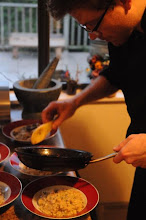45 minutes later, the garden room was already full and Mark was pouring drinks and bussing tables to compensate for my absence. No playful ribbing, no stern talk, just the cold shoulder as he worked his ass off. I am definitely feeling like an ass myself, and there is nothing I can do to make it better but start working hard enough that he doesn't have to. I kick into high gear, running drinks and seating tables, and Mark runs upstairs with his lunch. When he comes back down an hour later, he pours me a glass of Sandhill Chardonnay and says, “write me detailed tasting notes on this.”
I love an y boss who issues wine tastings as punishment. I can definitely enjoy this wine but I haven't yet memorized the precise criteria for the WSET tasting procedure. Clear, medium-intense/pale straw yellow in color, with a greenish hue.... strong bouquet of tropical fruit, orchardfruit, and butterscotch. Dry, with high acidity and high alcohol. Vanilla, green apples, apricot flavors. Well-structured, British Columbia Chardonnay (but at 14.5% alcohol and all that dried apricot and canned peaches flavor, I would normally guess Californian) with well-integrated of oak treatment. Will age well, is developing, but bloody great to drink now.
y boss who issues wine tastings as punishment. I can definitely enjoy this wine but I haven't yet memorized the precise criteria for the WSET tasting procedure. Clear, medium-intense/pale straw yellow in color, with a greenish hue.... strong bouquet of tropical fruit, orchardfruit, and butterscotch. Dry, with high acidity and high alcohol. Vanilla, green apples, apricot flavors. Well-structured, British Columbia Chardonnay (but at 14.5% alcohol and all that dried apricot and canned peaches flavor, I would normally guess Californian) with well-integrated of oak treatment. Will age well, is developing, but bloody great to drink now.
And then in comes Bill Sanford, former sommelier of the Fish House, as well as the Cannery, and now wine agent for Grady Wines. “Be more specific. Be systematic. Color – hues and intensity, presence of any flaws. Nose – aromatics and intensity, flaws. Palate – sugar, acid, alcohol, flavors and intensity of each. When I say intensity, I mean, is it low, medium, or high? If it's low, is it low-plus or low-minus, or just low? There are 9 possible intensities.” Holy shit... 10 if I include you, Bill. Glad you're around.
Then comes in Jeff, representing Aha Toro tequila. He brings in 3 huge handmade glass bottles of tequila blanco, reposado, and anejo: white, rested, and aged, respectively. These terms refer to the amount of time each 100% blue agave tequila has spent in toasted oak barrels. Blanco is virgin, reposado has rested for 6-8 months, and anejo is aged 12-18 months. Blanco is clear and smells like lime and black pepper, reposado is golden, like Cuervo Gold, but with a much more impressive and subtle nose with a little bit of toasted or smoked black pepper, and maybe even some caramel. Anejo is like scotch, smells like pencil shavings at first from all the oak but then transitions into sweet vanilla, finishing with black pepper. Fish House Chef Karen Barnaby enjoyed a good sniffing with us, and experienced in the anejo the aromas of strawberry, leather, and even caramelized passionfruit - “it's the smell of letting passionfruit puree reduce for a minute too long.” Only you, Chef.

No comments:
Post a Comment